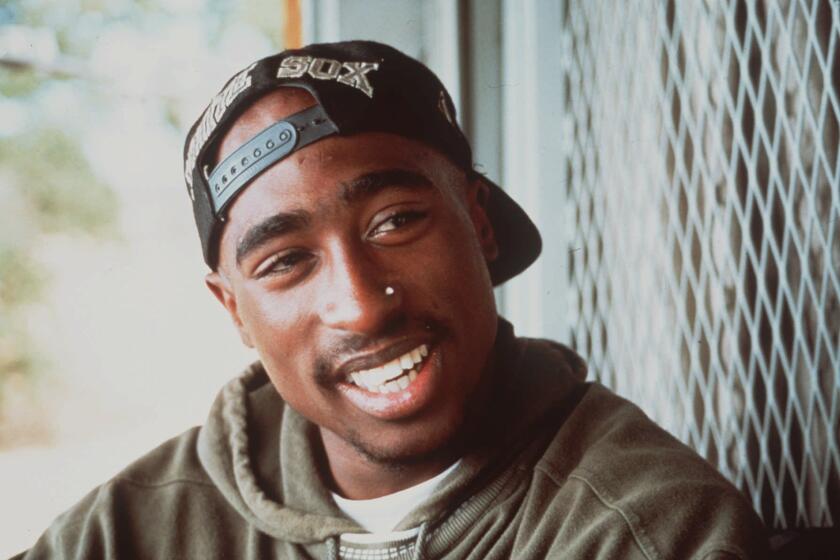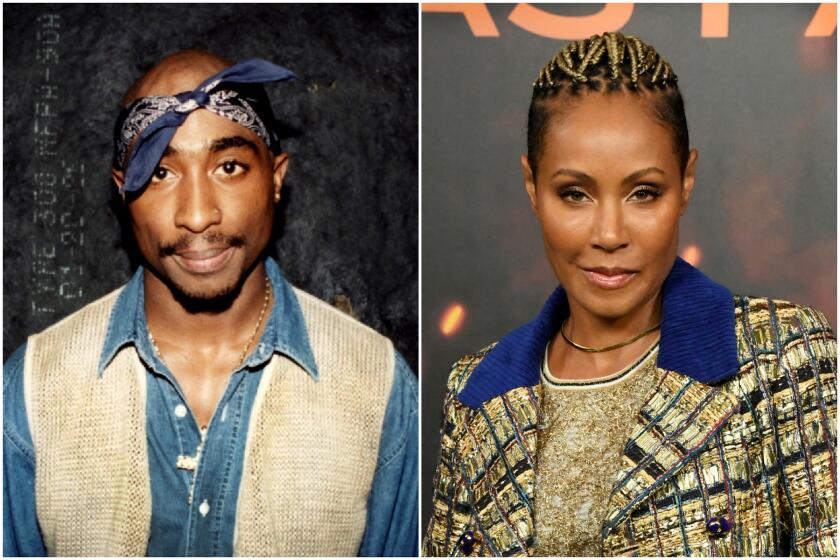No gun, no car, no witnesses: Lawyer says police have nothing but suspect’s stories in Tupac Shakur killing
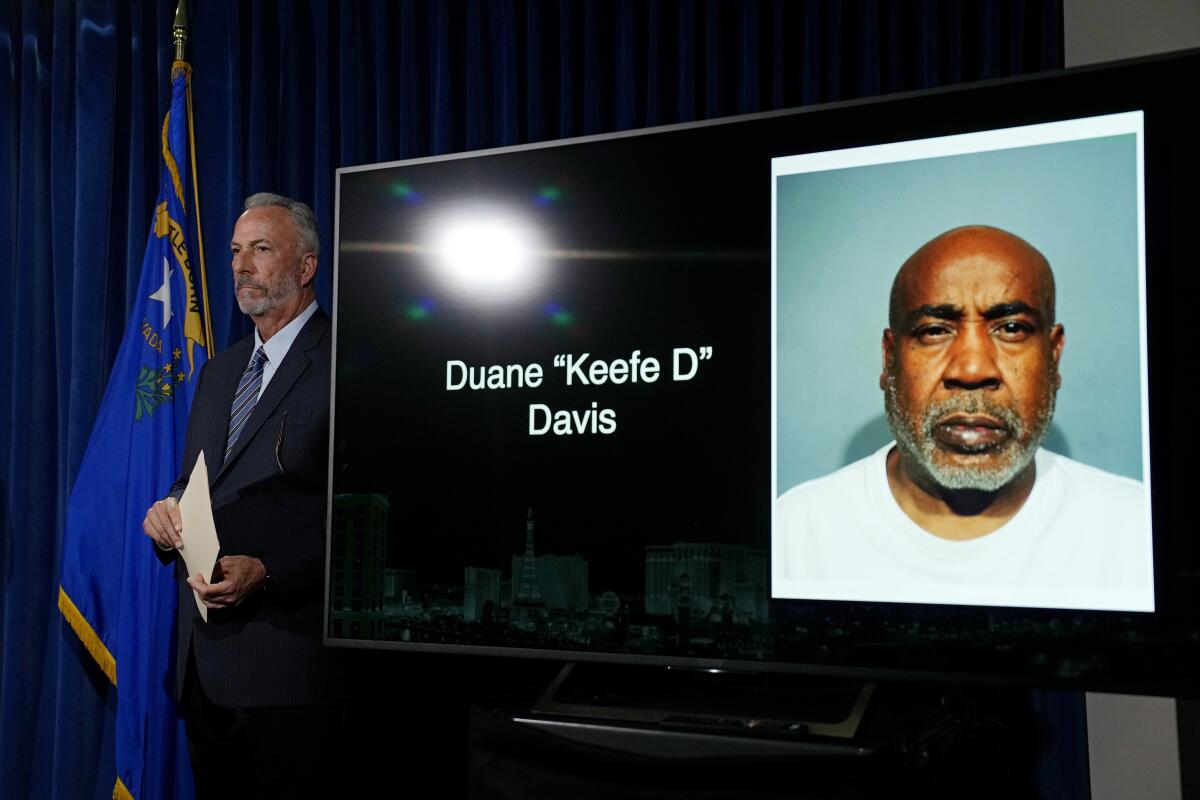
- Share via
Las Vegas Metro police had 27 years to make a case in the slaying of Tupac Shakur, but a new lawyer for the man accused of orchestrating the killing says authorities have no gun, no car and no witnesses.
The arraignment for Duane “Keffe D” Davis in Shakur’s 1996 killing was delayed Thursday for a second time, postponed for two weeks while a new lawyer, Ross Goodman, seeks to take over legal representation.
Authorities have said some of the most compelling evidence in the shooting comes from the suspect himself.
But Goodman, the son of former Las Vegas Mayor Oscar Goodman, questioned how authorities could verify the stories Davis, a former Compton gang leader, has recounted of his involvement in the deadly confrontation on Sept. 7, 1996.
“As everyone here knows, you have to corroborate those statements. You don’t have a car, you don’t have a gun and you don’t have witnesses to corroborate with what Mr. Davis said under those circumstances,” Goodman said. “I believe there is an obvious defense to that — why he made those statements and a motive for making those statements.”

Prosecutors say Davis, who was indicted by a grand jury on a charge of murder with a firearm, didn’t pull the trigger. He and Marion “Suge” Knight, the head of Death Row Records who was in the car with Shakur, are the only living witnesses.
Instead, Davis is accused of providing the gun and encouraging the killing as revenge for a beating that his nephew Orlando Anderson received at the hands of Shakur, Knight and other Mob Piru Blood gang members at the MGM Grand Hotel hours earlier.
Anderson, who was killed in a gang shootout in Compton a year and a half after Shakur’s death, was long considered the gunman; The Times identified him as such in 1998. At the time of Shakur’s shooting, he was in the back of the Cadillac with DeAndre “Big Dre” Smith, who died in 2004.
Davis identified Anderson as the shooter in 2008 when he finally talked to authorities with the protection of a proffer from the Los Angeles Police Department and FBI, meaning his statements could not be used against him.
In that interview, then-LAPD Det. Greg Kading asked whether Anderson, a.k.a. Baby Lane, was the shooter.
“He leaned over, and Orlando rolled down the window and popped him,” Davis replied. “If they would have drove on my side, I would have popped them. But they was on the other side.”
How Tupac Shakur’s killing in 1996 brought “10 days of hell” to Compton, with multiple shootings that helped crack the case.
Davis would go on to repeat that story in a series of internet and blog interviews.
But in his 2019 book, “Compton Street Legend,” Davis began to change the story.
“Tupac made an erratic move and began to reach down beneath his seat,” Davis wrote. “It was the first and only time in my life that I could relate to the police command, ‘Keep your hands where I can see them.’ Instead, Pac pulled out a strap, and that’s when the fireworks started. One of my guys from the back seat grabbed the Glock and started bustin’ back.”
Kading said that following the indictment, everything Davis said after the proffer and formal agreement with the U.S. attorney’s office is fair game for investigators, and every interview just made it easier to eventually charge him in Shakur’s death.
“He was the best witness against himself,” Kading said. “Ego and greed caught up with him.”
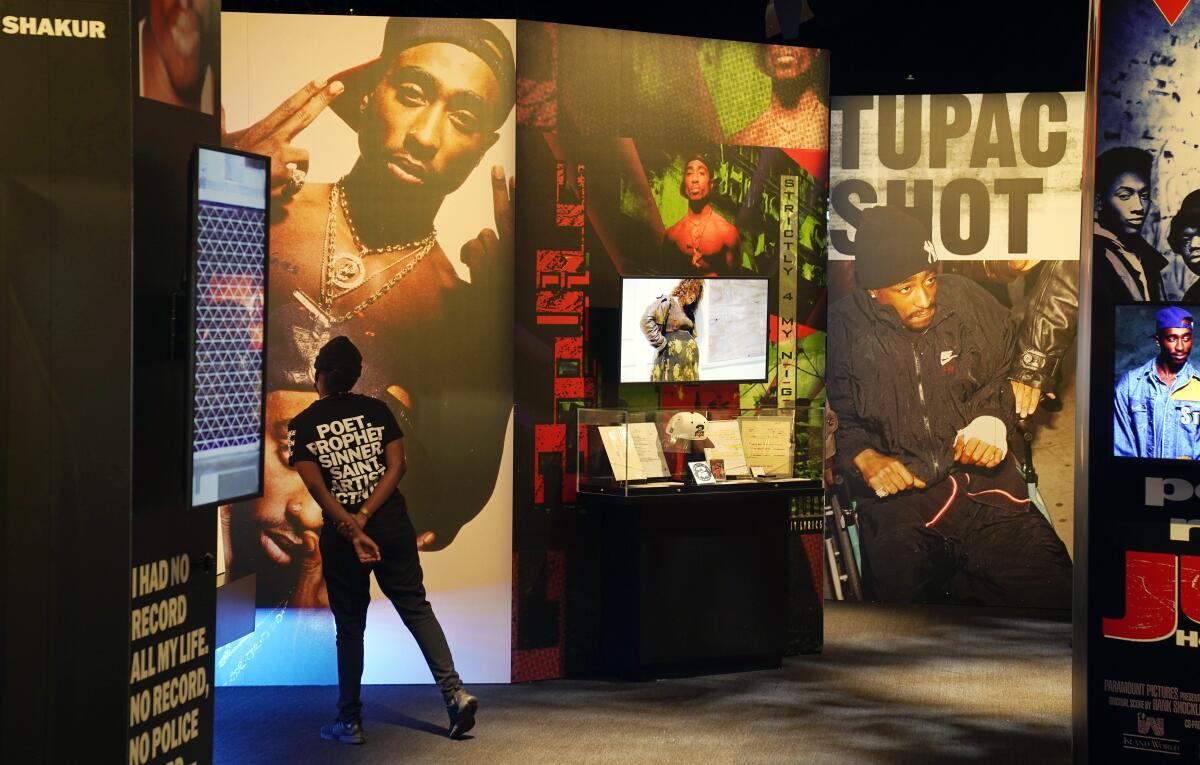
Standing outside the Clark County Courthouse on Thursday, Goodman said the statements to various media outlets and in Davis’ book were made shortly after Davis was diagnosed with colon cancer.
“I don’t know if that is a confession. That is a legal conclusion,” the lawyer said, casting doubt on whether it was true.
“It is a big case. It has been 27 years in the making. ... I understand there is about 600 pages of grand jury transcripts. Can you imagine the amount of evidence — potentially of impeachment evidence — that comes along with all these witnesses?” Goodman said.
When Kading and LAPD’s Daryl Dupree interviewed Davis in December 2008, they were seeking to solve the 1997 slaying of rapper Christopher Wallace, or “The Notorious B.I.G.,” also known as Biggie Smalls.
LAPD Chief William J. Bratton set up a task force of senior homicide detectives to find the killer in the wake of a wrongful death lawsuit against the city by the rapper’s mother, Voletta Wallace.
Task force members never determined who gunned down Wallace after a music industry party at the Petersen Automotive Museum. But as they explored whether the Southside Crips or Knight and the Mob Pirus were behind the shooting, they discovered evidence in Shakur’s slaying.
Kading said that Davis, under the proffer, could not incriminate himself in the interview. But the longtime gang member wanted to make money off Shakur’s death, prosecutors say, and kept talking outside the police interview. “He has talked himself into a corner.”
In his 2019 memoir and in several interviews, Davis admitted to riding in the car from which the fatal shots were fired at the Los Angeles hip-hop legend. Davis was taken into custody Friday morning.
But Davis believed he still had immunity, and in 2022, told Cam Capone News that it was the only reason he was not in custody for Shakur’s killing.
Kading said Davis orchestrated the slaying and Anderson fired the deadly shots, noting that Davis has added to his story over the years to make it sound like self-defense.
“When he was with us and he had to tell the truth, he gave us his [nephew’s] name,” Kading said. “Since then, he’s been vague deliberately.”
Kading said he has no doubt what Davis told LAPD detectives in that 2008 meeting is the truth because they had evidence of his role in a narcotics operation and bluntly told him to cooperate or face 25 years to life on federal drug charges.
“Keffe, today what we’re going to do, we’re just going to go over with a fine-tooth comb the Las Vegas incident,” Kading said at the time, according to transcripts. “But we do have to emphasize to you that everything in this report has to be right on, because if down the road it’s determined that some of these details are incorrect, then everything’s off the table.”
Davis then describes how a .40-caliber Glock popped out of a concealed compartment in the Cadillac. “Yeah. And I ain’t ever told nobody that story, man,” he said.
After being unable to find Shakur and Knight at a club where the rapper was due to perform, Davis said his crew made a U-turn after seeing Shakur’s BMW and Anderson started shooting.
Nearly three decades ago, Tupac Shakur was riding in a BMW driven by Death Row Records boss Marion “Suge” Knight.
Kading asked whether Knight saw him. Davis replied, “Yeah, he looked at me. … We’ve known each other since we was 7 or 8 years old.”
Davis continued: “I see the bullet go in Suge’s head. I thought he was dead. I thought he was dead. It must have scraped him or something, in the head or something. … I thought he was dead.”
After the shooting, Compton police saw “10 days of hell,” according to Robert Ladd, a former Compton detective who investigated Shakur’s death and the retaliatory killings that spiraled from it. By its end, three people were dead and 10 were wounded.
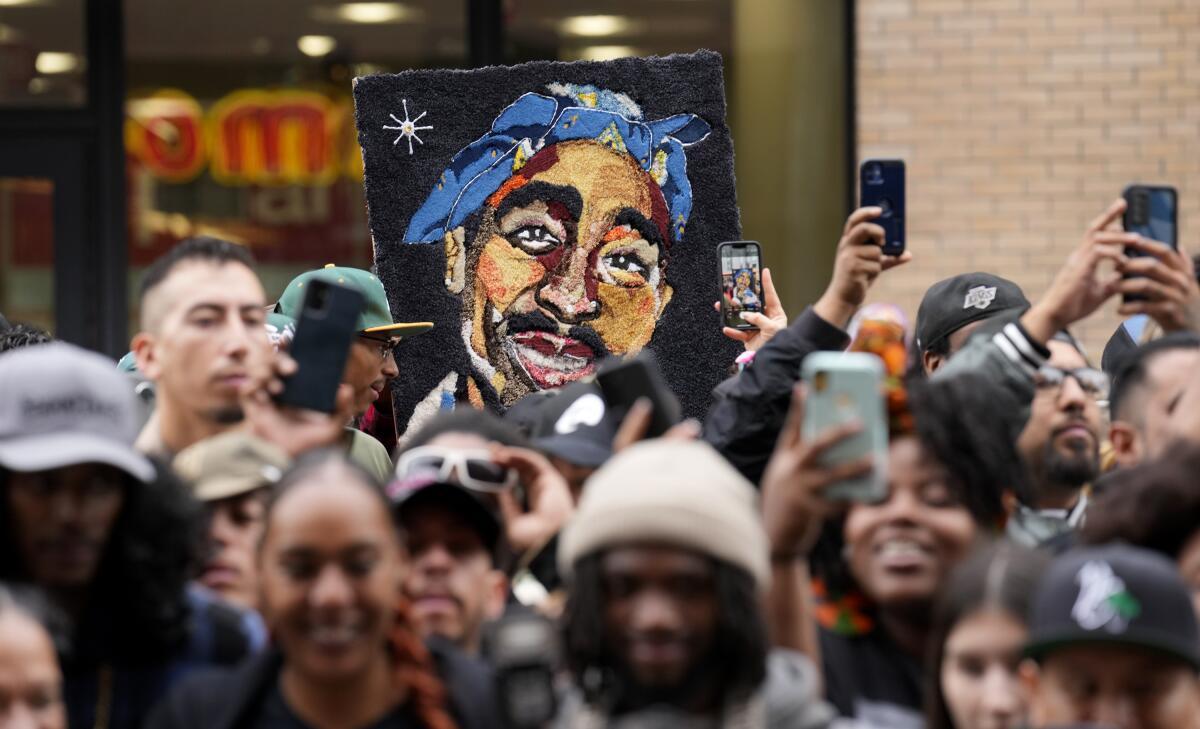
Solving Shakur’s killing was not the responsibility of the Compton police. But within a few weeks, they pieced together the deadly chain of events. An informant drew a line from Shakur’s fatal shooting to a fight that broke out two months earlier at the Lakewood mall. An informant said a member of Mob Piru named Travon Lane was shopping at a Foot Locker when some Southside Crips confronted him and took his “Death Row” necklace.
After watching Mike Tyson knock out Bruce Seldon at the MGM Grand on the night of Sept. 7, 1996, Shakur and his entourage spotted a lone Southside Crip in the casino’s lobby, the source told detectives. Lane recognized him as one of the men who stole his necklace and pointed him out to Shakur, who had recently inked “MOB” on his arm, the informant said.
Thanks to Kading’s 2011 book, “Murder Rap: The Untold Story of the Biggie Smalls & Tupac Shakur Murder Investigations by the Detective Who Solved Both Cases,” Davis’ statement was made public, and excerpts of his version of events made their way around the web.
By 2015, a documentary based on Kading’s work included recordings of the interview with Davis, who was acting as if the 2008 proffer still granted him immunity. Davis, who had been diagnosed with colon cancer the year before, jumped into a cottage industry of books, documentaries and magazine articles exploring conspiracy theories involving the slayings of Shakur and Wallace.
Four clips of those interviews would be played for the grand jury that indicted Davis on a murder charge in Shakur’s killing.
In the interviews, Davis claimed he sat in the passenger seat, with Terrence “Bubble Up” Brown driving and Anderson and Smith in the back. Davis said they went to Club 662, which was owned by Knight, to wait for Shakur to perform, but they left when the rapper didn’t show. Then, while driving away, they saw Shakur stick his head out of a car after some girls yelled his name.
“If he wouldn’t even have been out the window, we would have never seen him,” Davis said.
In subsequent interviews, Davis would repeat his account from the proffer interview and describe how his crew came upon Shakur’s entourage: They hit a U-turn and then “boom boom.”
Jada Pinkett Smith hopes for ‘answers,’ ‘closure’ after the arrest of a suspect in the murder of Tupac Shakur. Pinkett Smith and Shakur were close friends.
On the 25th anniversary of the fatal shooting, Davis did a 15-minute YouTube interview.
“Suge just ducked his head and the first bullet went in his head and the next ones hit him [Shakur] and he was trying to do a breakdance, trying to jump in the back seat or something. Looked like he was trying to jump up but bullets was hitting his ass. Once that windshield was shot out, pfff, it was over with after that.”
Davis later bragged how the four men behind the killing “started drinking” after they drove away.
Two people associated with the Southside Crips gang testified to the grand jury in August that they believed Smith was the shooter. One said Anderson could not get off the shot from his position in the back seat of the Cadillac.
Prosecutors wouldn’t identify the shooter, saying only that Davis handed the gun to one of the two men in the back seat.
“A lot of people bragged they shot Tupac; we know the reality,” Kading said.
Davis was so overt with his statements, the former detective said, that he “forced Las Vegas Metro’s hand with the public pronouncements.” That, along with “dogged detective” Clifford Mogg wanting to make an arrest in the case before retiring, led to the indictment, Kading said.
Under Nevada law, prosecutors need only show that Davis aided and abetted the killing of Shakur. During a July search of his Henderson, Nev., home, investigators seized dozens of photos and other memorabilia related to the hip-hop artist’s slaying.
Since his arrest last month, Davis remains in custody in Nevada. Goodman said if his representation of Davis is approved, he would seek release for his client. He said he won’t become the attorney of record until he reaches an agreement with Davis on representation. A judge warned Davis that if he doesn’t have any attorney within two weeks, a deputy public defender will be appointed.
“His spirits are fine right now,” Goodman said. “He wants to fight the case.”
More to Read
Sign up for Essential California
The most important California stories and recommendations in your inbox every morning.
You may occasionally receive promotional content from the Los Angeles Times.



